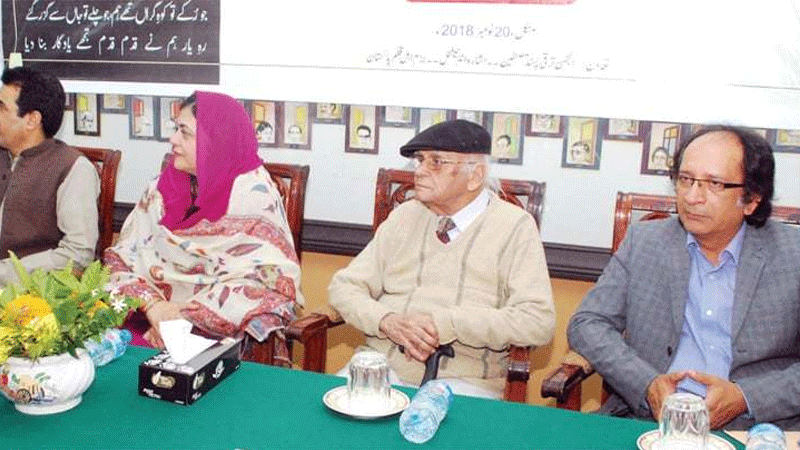Tracing Faiz Ahmed Faiz’s roots ahead of the Faiz Festival
The village of Kala Qader is located not too far from the Pakistan-India border. While the roadside milestones announce other towns and villages in the vicinity, this hamlet finds no such mention until the actual signboard, announcing it as the birthplace of Faiz Ahmed Faiz, comes into view.
Despite my weariness from having travelled hours on bumpy, single-lane country roads, the sign has the Faizophile in me buzzing with excitement.
In Lahore today, preparations are in full swing to hold the Faiz Festival, a celebration of the intellectual’s impact on Pakistan’s literary landscape and beyond.
In fact, with every passing day, the man and his body of work is rendered emphatically relevant. In Pakistan, one finds him regularly featuring on the literary festival circuit, his verses appearing in popular culture via outlets such as Coke Studio. Even in neighbouring India, his presence is greatly felt — the most recent example that springs to mind was the evocation of his poem Hum dekhein ge by students of various universities.
But while Lahore continues to reap the fruits of his popularity, what of his ancestral village and Sialkot, the city where he spent his youth. Now dubbed Faiz Nagar, the former is now merely a footnote in Faiz’s life story, while the latter pays greater homage to its other poetic scion — Allama Iqbal — than it does to Faiz.
History recalls that Faiz visited his ancestral village during his youth, and then returned only a couple of days before his passing, reminiscent of local lore of the soil, calling to the prodigal son for a final farewell, just before the curtain falls.
While many villages surrounding Sialkot have merged with the city over time, Faiz Nagar, by virtue of being far removed from the major urban centre, still retains some of its old-world ethos.
We are shown around by Ghulam Sarwar, the village elder and extended family member to Faiz.
He leads us down a typically dingy village lane to a house with a door that stands out for its strikingly elaborate woodwork.
A plaque announces it as the abode of Faiz’s father, Sultan Ahmad Khan, who spent a substantial part of his life in Afghanistan at emir Abdul Rehman’s court. The house, we are told, was once part of a larger compound-style haveli [mansion]. Now, it is sandwiched between comparatively recent constructions that bear none of the aesthetics of old havelis or the earthy poetics of mud-baked houses that surely dotted the landscape when Faiz would have visited here as a young man.
Then, there is the fabled mosque; the ageing yet imposing structure with exotic domes reminiscent of Central Asia, built as it was by artisans from Afghanistan.
This was the place where, on his final trip, Faiz led the evening prayers and wrote a Persian naat, which is now inscribed on the outer wall. It was his own quiet way of professing his deep rooted faith.
Dr Saadat Saeed, poet, critic and professor of Urdu at GC University, Lahore, notes that unlike many of his progressive contemporaries, Faiz never explicitly attacked religion or hurt religious sentiment, choosing instead to employ religious references in his most famous works.
“After all, how religiously irreverent could someone who professed lifelong devotion to Allama Iqbal really be?”
In the idyllic surroundings of Faiz Nagar, it isn’t very hard to hear echos of the great man and the more discerning student of his work can see where his penchant for juxtaposing what passes for beauty against the ugliness of injustice, tyranny and oppression, his desire to empower the downtrodden, really comes from.
There are elements of the economic and social disparity, reflected in his writings, around us as we walk through his ancestral village. One can imagine the penury he faced after his father’s untimely demise, long before he became enamoured of Marxist beliefs.
Faiz’s biography, Love and Revolution, written by his grandson Dr Ali Madeeh Hashmi, recounts a young Faiz’s discomfort at the contrast between the poverty-stricken villagers and his own privilege, to the extent that his “father’s being a Khan Bahadur became like a burden” for him.
Conversely, Faiz continues to be a presence in his village. There are repeated references to the maternity home-cum-dispensary built in his memory by the Faiz Memorial Committee.
Then there is the Faiz Aman Mela, which was clearly a high point for the sheltered villagers. There are accounts of how Faiz’s immediate family travelled down for the mela [fair] and were treated to local delicacies like saag with makai, bajra and gawar rotis. Moneeza Hashmi managed to rope in celebrities, like Arif Lohar, to perform and free food was dispensed to all the attendees.
But over in Sialkot, where he spent a significant portion of his early life, it seems as if Faiz was never there. There is nothing, not even a token street, library or a study centre named after its other son (Faiz, not the Poet of the East). One of the chief reasons for this could be that after the death of his father, the haveli Faiz grew up in was sold off to pay debts, severing the family’s immediate connection to the city.
Originally published in Dawn, February 17th, 2023











